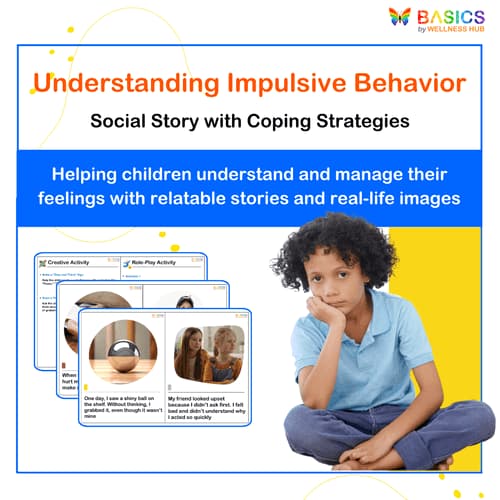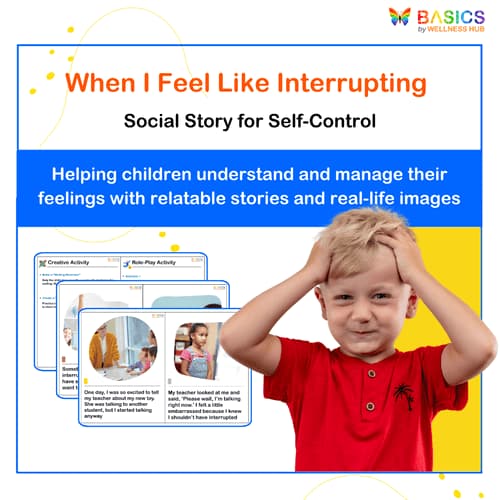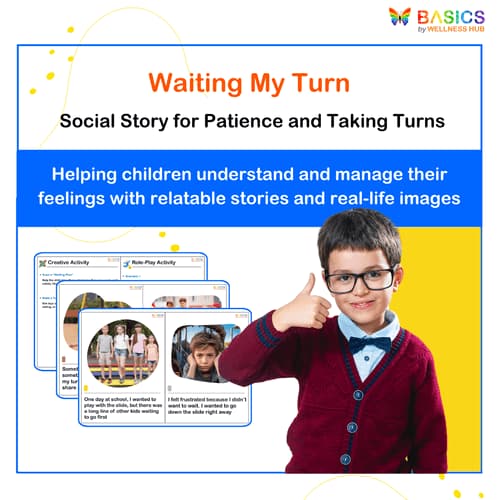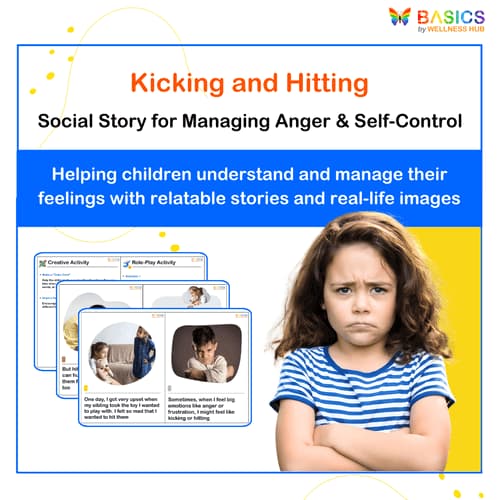





Big and Small Flashcards: Pre-Math Concepts for Kids
₹80
₹160
50% off
0 (0 ratings)
Grade Levels
Pre-K - Grade 1 (Ages 3-6)
Content Overview
Format: PDF, Total Pages: 12, Features: 48 pairs of big and small objects with high-quality illustrations.
Categories
Pages from the Resource
Teach pre-math concepts with our "Big and Small Flashcards: Pre-Math Concepts for Kids." This resource includes 48 pairs of objects—like big table, small table, big elephant, small mouse—helping young learners develop size comparison skills, which are essential for early math understanding.

Page 1

Page 2
What Users Say
0
0 ratings
5
0+
4
0+
3
0+
2
0+
1
0+
5 Stars
Product is Good to use.
10 months ago
Varsha Parent
Similar Products

Understanding Impulsive Behavior: Social Story with Coping Strategies
₹ 80.00
₹ 160.00
50% off
4.9 (42 ratings)

When I Feel Like Interrupting – Social Story for Self-Control
₹ 80.00
₹ 160.00
50% off
4.8 (60 ratings)

Waiting My Turn – Social Story for Patience and Taking Turns
₹ 80.00
₹ 160.00
50% off
4.7 (56 ratings)

Kicking and Hitting – Social Story for Managing Anger & Self-Control
₹ 80.00
₹ 160.00
50% off
4.6 (52 ratings)

Understanding Swear Words – Social Story for Respectful Communication
₹ 80.00
₹ 160.00
50% off
4.9 (48 ratings)
About the Product
Purpose of the Flashcards: The "Big and Small Flashcards: Pre-Math Concepts for Kids" resource is designed to introduce young learners to the foundational pre-math concept of size comparison. By focusing on identifying and distinguishing between big and small objects, children develop crucial visual discrimination and cognitive skills, laying the groundwork for more advanced mathematical understanding in the future.
Target Audience: This resource is perfect for parents, early childhood educators, and special education professionals who want to engage children ages 3-6 in activities that teach size comparison. The flashcards are suitable for both one-on-one instruction and group settings, making them versatile tools in various educational environments.
Product Details
Content Description: The set consists of 48 pairs of big and small objects, organized into a 12-page high-quality PDF. The first six pages feature pairs of identical objects in different sizes, such as "big table, small table" and "big flower, small flower." The remaining six pages highlight pairs of related objects from the same category, like "big elephant, small mouse" and "big ship, small boat." Each page contains four pairs of objects, presented with clear, child-friendly illustrations and simple labeling.
Image Quality and Design: The flashcards feature vibrant, high-resolution images that are visually appealing and easy for children to understand. The straightforward design allows learners to focus on the key concept of size comparison without unnecessary distractions.
Educational Benefits
Pre-Math Skill Development: These flashcards are designed to build the foundational skill of understanding size relationships, a critical pre-math concept that paves the way for learning about measurements, quantities, and spatial reasoning.
Cognitive and Visual Discrimination: The process of identifying and distinguishing between big and small objects enhances cognitive abilities and visual discrimination skills, helping children make sense of the physical world around them.
Language Development: As children learn to describe objects based on their size (e.g., “big boat” versus “small boat”), they naturally expand their vocabulary and improve their descriptive language skills.
Categorization Skills: The flashcards encourage children to group objects based on shared characteristics, such as size and category, which aids in developing organizational and critical thinking skills.
Instructions for Use
Printing Recommendations: For optimal durability and clarity, print the flashcards on thick, glossy cardstock. This ensures that the images are vibrant and that the cards are sturdy enough to withstand regular use in both classroom and home settings.
Cutting and Preparation: Cut the flashcards along the indicated lines to separate each pair. Laminating the flashcards is recommended, especially if they will be used frequently by young children.
Utilization Tips
Introduction and Familiarization: Start by introducing a few simple pairs (e.g., "big table, small table") to build familiarity with the concept. Gradually introduce more complex pairs, such as those with objects from different categories, as the child’s understanding deepens.
Interactive Games: Use the flashcards in matching games where children are asked to find the big and small versions of the same object or related objects. This can be done individually or as a group activity.
Real-Life Object Comparisons: Reinforce learning by asking children to compare the flashcards to real-life objects around them. For example, after showing a "big ship, small boat" flashcard pair, encourage them to identify similar size relationships with toys or other objects in the room.
Group Learning: The flashcards can be used in group activities where children take turns identifying big and small objects, helping to develop social skills along with pre-math concepts.
Activities Using the Resource
Big and Small Matching Game: Lay out the flashcards and ask children to match the big and small versions of the same object. For example, match the "big table" card with the "small table" card. This activity reinforces the concept of size comparison and helps children visually distinguish between objects of different sizes.
Sorting and Categorization: Group the flashcards based on categories such as "same object" (e.g., "big flower, small flower") or "related objects" (e.g., "big ship, small boat"). This activity helps develop categorization skills and introduces more complex relationships between objects.
Interactive Storytelling: Use the flashcards to create fun stories that involve big and small objects. For example, a story about a "big elephant" and a "small mouse" on an adventure can be an enjoyable way to reinforce the size comparison while enhancing creativity and language skills.
Size Scavenger Hunt: After introducing the flashcards, engage children in a scavenger hunt where they find real-life examples of big and small objects in their environment. For instance, they can find a "big ball" and a "small ball" in the playground. This activity connects the learning from the flashcards to the real world.
Memory Match Game: Place the flashcards face down and ask children to flip them over two at a time to find matching big and small pairs. This game is not only fun but also helps improve memory and concentration while reinforcing the size comparison concept.
FAQs
Q1: Are these flashcards suitable for children who are just starting to learn about sizes?
A1: Yes, these flashcards are perfect for beginners as they introduce size comparison in a simple, easy-to-understand format. The resource starts with matching identical objects of different sizes before progressing to more complex comparisons of related objects.
Q2: How can I ensure that the flashcards remain durable over time?
A2: We recommend printing the flashcards on thick cardstock and laminating them. This makes them sturdy and capable of withstanding frequent use, especially by young children.
Q3: Can these flashcards be used in a classroom setting?
A3: Absolutely! These flashcards are versatile and can be used in both individual and group activities. They are well-suited for classrooms, homeschooling, and therapy sessions.
Q4: How many flashcards should I introduce at a time?
A4: Start with just a few pairs, especially those featuring familiar objects. Gradually introduce more pairs as the child becomes comfortable with the initial set. This approach prevents overwhelming the child and allows for gradual learning.
Q5: Are these flashcards beneficial for children with special needs?
A5: Yes, the clear visuals and simple concept of size comparison make these flashcards highly effective for children with special needs, particularly those with cognitive or language delays.
Usage Rights and Restrictions
Usage Guidelines: These flashcards are intended for personal and educational use only. Purchasers may print and use them in a single home or classroom setting. The digital file and printed copies cannot be shared, redistributed, or sold. Unauthorized commercial use, mass distribution, and sharing outside of the purchaser’s environment are prohibited.
Conclusion
Thank you for choosing 'Big and Small Flashcards: Pre-Math Concepts for Kids.' We hope this resource helps build a solid foundation for your child’s early math and cognitive skills. Whether used at home, in the classroom, or during therapy sessions, these flashcards are designed to make learning both engaging and effective. Wishing you and your young learners much success on your educational journey!



